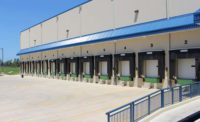Modern food processing facilities are challenged daily with many risks. The foods being processed must remain safe from physical, biological and chemical hazards. Entire production lots can be ruined due to an air pressure control failure. Air pressure differentials that ensure airflow from ready-to-eat (RTE) to less hygienic areas of a processing facility could lead to huge losses as a result of an adulteration incident.
With efficient engineering, air pressure control can be achieved with components selected for construction that can have a positive impact on enclosing the processing facility. Insulated metal panels (IMPs) are the prime product that can deliver the needed performance to control air pressure.
Air leakage through a building envelope is not acceptable as natural ventilation. Furthermore, air leakage into a building cannot be controlled or filtered and will not provide evenly distributed ventilation. In addition, warm air leaks will carry moisture, which may condense within the assembly and lead to structural degradation. A quality building should be designed in a way that ensures the envelope will be airtight and only engineered ventilation will occur.
Several questions need to be answered in the design phase to ensure air pressure is properly controlled in a food processing facility. What's the R-value of the insulation in cold storage areas? How well do cold storage doors prevent humidity ingress into loading docks? What materials form the walls? To address consumer safety concerns, U.S. Department of Agriculture (USDA) regulations have placed significant importance on the Hazard Analysis Critical Control Plan (HACCP) for food processing facilities. That plan recognizes how structural design can have a positive effect on air pressure efficiency in modern food processing facilities.
Wind conditions can be a primary cause that allows the passage of air through structural joints affecting the air pressure difference between the interior and exterior. High differentials in pressure can occur with even small wind velocities. To maintain air pressure and hygiene in a modern food processing facility, the walls should be impervious, flat and smooth, completely free of pits and cracks and non-absorbent. They should also be resistant to corrosive sanitizing chemicals and easy to maintain. Insulated metal panels, when properly installed and sealed, handle all of these requirements from the floor to the ceiling.
Walls with poor quality insulation are a threat to food processing in the event of an electrical outage of the refrigeration units. Cold storage doors with insufficient airtightness control could allow unsafe temperature drops during periods of heavy traffic in shipping and receiving. If materials used to form walls begin degrading after multiple cleanings, small cracks and pits can form that may harbor biological pathogens. IMPs create an airtight barrier to prevent mold and other airborne adulterants from collecting and growing unnoticed before the entire facility must be shut down for inspection and costly mold removal.
The ability of a building to prevent air from passing through is a very important part of air pressure control in modern food processing facilities. This is secured by controlling the movement of air through construction joints. An airtight building envelope will reduce heat loss, but will also prevent vapor diffusion and lead to improve thermal and acoustic performance, as well as more efficient control of interior conditions.




